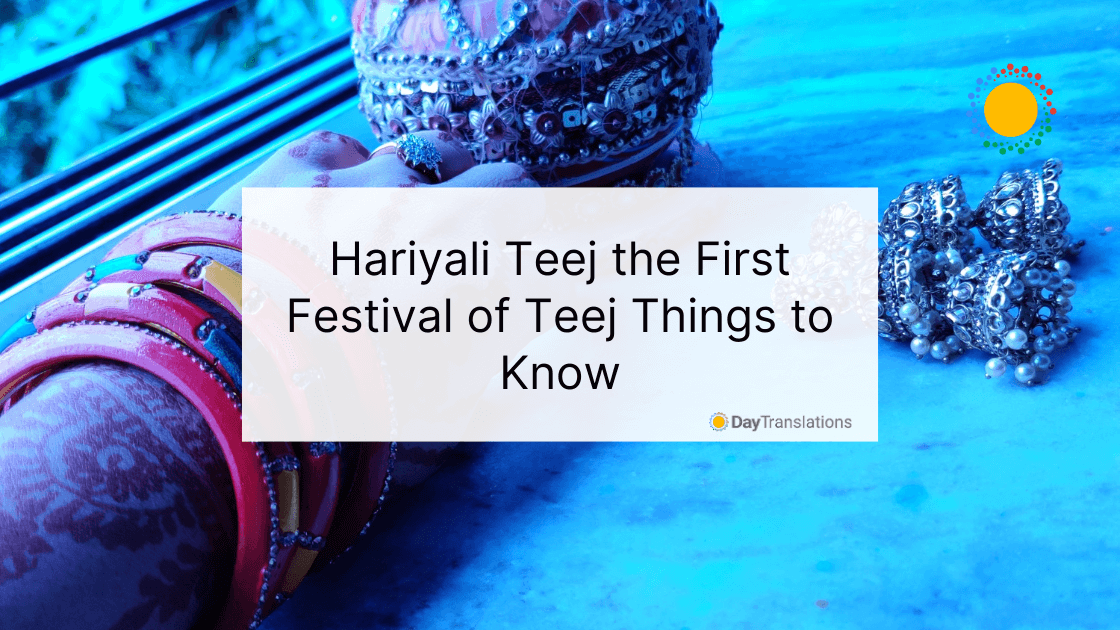Indians welcome the monsoon season and one of the festivals they observe primarily for women is the Teej festival.
What is the Teej Festival?
The Teej festival is celebrated by Hindu women in Northern India and Nepal, typically involving prayer rituals, dancing and singing. Women get together, tell stories, and wear clothes in bright colors, such as orange, green or red. They usually have their hands and feet beautifully decorated with henna.
It starts with the Hariyali Teej. This year, it falls on August 3. “Teej” means third (day) in the local language or more precisely, the third day of the month after the new moon and third day of the month after the full moon during the monsoon months between July and September.
The other two Teej festivals are Kajari Teej observed on August 18 and Hartalika Teej on September 1 this year.
What is Hariyali Teej?
Hariyali Teej is a festival for married and unmarried Hindu women, to celebrate their husbands’ wellbeing and their marital bliss. They observe Hariyali Teej by fasting. During the Teej festivals married women pray to the goddess Parvati and the fasting is done to ask the goddess to grant their husbands a long life. Unmarried women on the other hand fast and pray to find a good husband.
Hindus believe that Parvati did self-mortification many times and continuously prayed until Lord Shiva admitted her as his wife, which happened after her 108 births and reincarnations.
The monsoon season in India ushers in a series of celebrations and Teej is just one of them. For the Hindus, it’s a glorious season, as the Earth will have a new face after the hot and dry seasons. With the rain, the surroundings will be greener and lusher, which is one of the reasons why Hariyali Teej is associated with joyous celebration.
In Hindi, Hariyali refers to the color green. On Hariyali Teej, many women use different hues of green to adorn themselves. The day is spent fasting and praying to goddess Parvati as well as to Lord Shiva for marital bliss. Young women are also encouraged to fast.
Fasting rituals vary. Some drink milk and eat fruits throughout the day while others avoid drinking water (nirjala vrat) while fasting. Women offer turmeric-coated rice, flowers, fruits and bel patra leaves to Parvati. They listen to folk tales and sing songs during this day.
After they break their fast, they are treated to a vegetarian meal that includes papad (crispy flat bread), different curries, pulav or pulao and dal. They have special sweets like ladoo and ghevar.
The Significance of the Bel Parta
There is an interesting story about the bel parta (bilva/bilwa leaf) and why it is offered together with flowers and fruits to goddess Parvati. The leaves are often offered to Parvati and Shiva, as well as other deities.
The bel parta is trifoliate in appearance, meaning each leaf stalk contains three leaves. According to Hindu scriptures, the leaves represent Brahma, Vishnu and Shiva or the holy trinity. The scriptures also explain that the bel parta is a representation of Lord Shiva’s three eyes. They believe that if they offer bel parta leaves to Lord Shiva, their wishes will be granted. Another Hindu belief is that the bilwa or bel tree grew from the sweat of Parvati and she is in every part of the tree. Hindus also call Parvati as Mata Teej.
Celebrating Hariyali Teej
Hariyali Teej is called differently in other parts of India. It’s called Shingara Teej in Rajasthan and Teeyan in Punjab. Even the celebration of Hariyali Teej differs according to region. Some Indian states declare it as a restricted or official holiday.
The names for the festival may be different but the enthusiasm it generates is the same. In whatever manner it is celebrated in each region, it commemorates Lord Shiva and goddess Parvati’s union.
Traditionally, the Hariyali Teej is observed in Rajasthan and in the Punjab region in Northern India.
Hariyali Teej in Punjab
In Punjab, girls play on swings set up in open courtyards and under some trees. Family members, in-laws and husbands present women and girls with various gifts such as new accessories and clothes. Boys play outside or help prepare special sweets at home.
In Chandigarh (also in the Punjab region), the city’s Rock Garden becomes the venue for cultural programs and school plays. At home, daughters and other female family members are given dresses and gifts. The special gifts mothers give to their married daughters are called sindhara.
In Punjab’s city of Haryana, Hariyali Teej is an official holiday and one of its most popular festivals, with the city government joining in the celebration. It’s a tradition for young boys to fly kites while girls play on swings all day as they are excused from doing household chores. Parents also give them new clothes. Girls decorate their feet and hands with different designs using henna. Offerings of food are placed in front of an image of Parvati. Prayers, folk dancing and singing are reserved for evening entertainment.
Hariyali Teej in Rajasthan
Rajasthan becomes quite a festive place when celebrating Hariyali Teej, what with the swings placed under trees and women and young girls having fun riding them. It’s quite a sight to see most of the women in Rajasthan wear green clothes on this day. Songs fill the air and lavish processions are held for two days.
Activities Related to Hariyali Teej and the Teej Festival
The celebration of the Teej festival and Hariyali Teej is both solemn and joyous. Processions, storytelling, singing, dancing, games and gift giving represent the joyous activities. As a religious observance, the prayers, offerings, fasting and temple visits make it a solemn occasion as well.
Typical activities during the entire Teej festival include the following:
· Married couples visit the temples of Parvati and Lord Shiva on Hariyali Teej. They pray to have a good married life and offer bhog and red flowers.
· Traditional songs related to Teej are sung. Women wear traditional clothes, mostly in hues of green. They adorn themselves with gold and diamond jewelry, beautiful bangles (mostly green) and apply mehndi or henna on their hands and feet.
· It is a tradition to have swings set up under trees and open courtyards.
· Married women visit their mothers, who present their daughters with a gift basket containing bangles, henna, ghevar and fruits. They also receive gifts from their in-laws.
Symbolisms
The gifts are very significant to married women as they are symbols of their marriage. Wearing the gifts is said to bring them good luck.
The application of henna during Hariyali Teej is also very significant. According to local belief, the color of the henna on a woman’s hand indicates the level of love her husband or fiancé bestows on her. Following the belief, the darker the henna color when applied to the hands and feet, the deeper the man in their life loves them. In some places in India, the women include the name of their partner in the henna designs.
The swings are usually tied to the branches of the banyan tree, also called Vat Vriksha. The banyan tree is a sacred object in Hindu mythology and its branches represent knowledge. Women are allowed to have fun and be merry on Hariyali Teej. They feel free while having swing rides, which is a form of worshiping the banyan tree as well. Incidentally, the banyan is India’s national tree. Hindus believe that Krishna rests on the leaves of the banyan tree. The tree is also related to Lord Shiva, who is often depicted sitting under the tree in complete silence, with sages (rishis) near his feet.
Teej symbolizes the sacrifices a wife goes through to win the heart and mind of her husband. It’s a festival honoring women and marks the union of a couple. There are several more reasons to celebrate Teej and some of them are physical. It is the time to rejoice as the monsoons bring new hope, allowing the Earth to soak up water and help plants grow. It’s the time for people, especially in Rajasthan, to find much needed relief after the sweltering heat of the dry season.
Do you want to understand local culture? We can help.
If you are interested in exploring other countries, it’s best to understand a country’s literature, witness its festivals and immerse in its history. You are likely to discover more about the country and its people from their literature and their festivals. We at Day Translations, Inc. love opening the doors to different cultures for you through accurate translations done by professional, native speaking translators who live in-country. If you need language services, give us a call anytime at 1-800-969-6853 or send us an email at Contact us. You can reach us anytime of the day wherever you are as we are open 24/7, each day of the year












Sorry, the comment form is closed at this time.